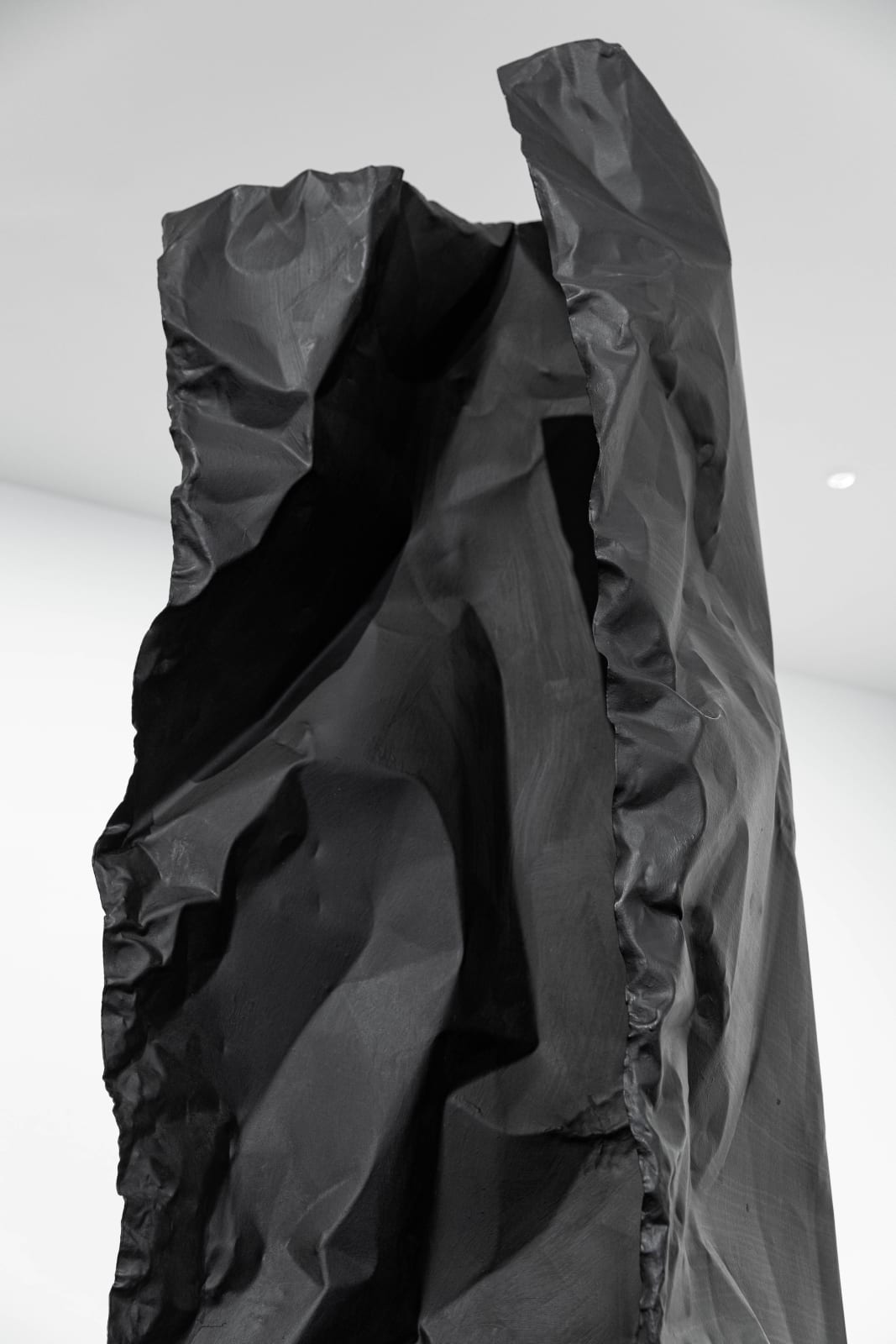-
artworks
Rosemarie Castoro
Black Flasher B, 1979Galvanized steel and paint250 x 70 x 74 cm
98 3/8 x 27 1/2 x 29 1/8 inchesCourtesy Galerie Thaddaeus Ropac, London • Paris • Salzburg © The Estate of Rosemarie CastoroPhoto: Dirk TackeWeitere Abbildungen
Die abstrakten Formen der hohen, raumgreifenden Stahlskulpturen Black Flasher A und Black Flasher B (beide 1979) gehen auf die Modellierfähigkeit des Materials Papier zurück. Einer privaten Geschichte zufolge, hatte Castoros...Die abstrakten Formen der hohen, raumgreifenden Stahlskulpturen Black Flasher A und Black Flasher B (beide 1979) gehen auf die Modellierfähigkeit des Materials Papier zurück. Einer privaten Geschichte zufolge, hatte Castoros Mutter ihr 20-Dollar Geldscheine in eine Coca-Cola Flasche gesteckt und zugeschickt. Anschließend zerknitterte Rosemarie Castoro die normalerweise flachen 20-Dollar-Geldscheine weiter und stellte sie auf ihre schmale Kante aufrecht hin, wodurch sie die plastischen Eigenschaften des funktionalen Geldscheins spielerisch erkundete.
Die beiden Black Flashers sind aus dünnem Stahl gefertigt und mit mattschwarzer Acrylfarbe bemalt. In diesen Werken spannt Castoro einen Bogen zu ihrer choreographischen und körperbezogenen Arbeit aus der Mitte der Sechziger Jahre wodurch sich ihr anhaltendes Interesse für die physische Erforschung des Raumes und dem Verhältnis zwischen Körpern und Geometrie bestätigt. In postminimalistischer Manier wird die geometrische Form (hier die rechteckige Grundform der Stahlblätter) als Ausgangslage verwendet und durch eine sinnliche Komponente erweitert, indem der Stahl zusammengeknittert und mit Farbe bemalt wird. Gleichzeitig wird sie mit dem persönlichen und autobiografischen Element der Erzählung über den Entstehungsprozess ergänzt und durch den Titel Flasher sexualisiert. Der Titel Flasher (dt. Exhibitionist) verweist auf diese körperliche Qualität der Skulpturen und impliziert physische Exponierung, jedoch tendenziell auf eine unscheinbare Weise. Auszeichnend für Künstler/innen der Postminimal Art ist, dass sie in Form eines Weiterdenkens der Minimal Art, die Abstraktion auch in Bezug auf den subjektiven und erotisierten Körper und die individuelle Psyche untersuchten.
Die Werke wurden seit 1979 mehrfach im öffentlichen Raum in New York und Paris auf Gehwegen und Plätzen ausgestellt– die Begegnung mit dem/der Betrachter/in und die Gegenüberstellung von Körperlichkeit ist ein elementarer Bestandteil der Arbeit. Die Arbeiten Black Flasher A und Black Flasher B waren prominent in den beiden Ausstellungen im MACBA (2017) und MAMCO (2019) gezeigt.
The abstract forms of the tall, expansive steel sculptures Black Flasher A and Black Flasher B (both 1979) derive from the modelling qualities of paper. According to a personal story, Castoro's mother had put a few $20 bills into a Coca-Cola bottle and sent it to her. Rosemarie Castoro then continuously crumpled the initially flat $20 notes and placed them upright on their narrow edges, playfully exploring the sculptural characteristics of the bills.
The two Black Flashers are made of thin steel and painted with matt black acrylic paint. With these works, Castoro draws a link to her choreographic and body-related works from the mid-1960s, confirming her ongoing interest in the physical exploration of space and the relationship between bodies and geometry. In a post-minimalist manner, the geometric form (here the basic rectangular shape of the steel leaves) is used as a starting point and expanded by a sensual component by squeezing the steel and painting its surface. At the same time, it is supplemented with the personal and autobiographical element of the narrative about the process of creation; further sexualized by the title Flasher. The title refers to this physical quality of the sculptures and implies an inconspicuous physical exposure. This is a known characteristic of Postminimal artists: investigating abstraction in the form as a further development of Minimal Art, also in regard to the subjective and eroticized body and the individual psyche.
The works were exhibited several times after 1979: in public spaces such as on sidewalks and squares in New York and Paris. The encounter with the viewer and the juxtaposition of physicality is an elementary part of the work. The works Black Flasher A and Black Flasher B were prominently featured in the two exhibitions at MACBA (2017) and MAMCO (2019).exhibitions
1979 Artpark, Lewiston New York, US
1983 Public Art Fund, Chambers & Hudson Streets, New York, US
1983 Banks of the Seine River, Paris, FR
1984 780 Third Avenue, New York. US
2017 “Focus at Infinity”, MACBA, Barcelona, ES
2019 “Time = space between appointment and meeting”, MAMCO, Geneva, CH











